Assessing Urban Landslide Dynamics through Multi-Temporal InSAR Techniques and Slope Numerical Modeling
Abstract
:1. Introduction
2. Study Area
3. Materials and Methods
3.1. SAR Data and MT-InSAR Methods
3.2. Statistical Post-Processing of PS Measurements
3.3. Ground-Based Data, Model Setup, and Numerical Modeling
4. Results
4.1. MT-InSAR Outputs
4.2. Numerical Simulations
5. Discussion
5.1. MT-InSAR Outputs and Numerical Simulations
5.2. Benefits and Limitations of the Analysis
6. Conclusions
Author Contributions
Funding
Acknowledgments
Conflicts of Interest
References
- Fastellini, G.; Radicioni, F.; Stoppini, A. The Assisi landslide monitoring: A multi-year activity based on geomatic techniques. Appl. Geomat. 2011, 3, 91–100. [Google Scholar] [CrossRef]
- Alexander, D. Urban landslides. Prog. Phys. Geogr. 1989, 13, 157–189. [Google Scholar] [CrossRef]
- Haque, U.; Blum, P.; da Silva, P.F.; Andersen, P.; Pilz, J.; Chalov, S.R.; Malet, J.P.; Auflič, M.J.; Andres, N.; Poyiadji, E.; et al. Fatal landslides in Europe. Landslides 2016, 13, 1545–1554. [Google Scholar] [CrossRef]
- Kjekstad, O.; Highland, L. Economic and Social Impacts of Landslides. In Landslides—Disaster Risk Reduction; Sassa, K., Canuti, P., Eds.; Springer: Berlin/Heidelberg, Germany, 2009; pp. 573–587. ISBN 978-3-540-69966-8. [Google Scholar]
- Schuster, R.L.; Fleming, R.W. Economic Losses and Fatalities Due to Landslides. Environ. Eng. Geosci. 1986, xxiii, 11–28. [Google Scholar] [CrossRef]
- Froude, M.J.; Petley, D.N. Global fatal landslide occurrence from 2004 to 2016. Nat. Hazards Earth Syst. Sci. 2018, 18, 2161–2181. [Google Scholar] [CrossRef] [Green Version]
- Petley, D.N. The global occurrence of fatal landslides in 2007. In Proceedings of the Geophysical Research Abstracts EGU General Assembly, Vienna, Austria, 13–18 April 2008; Volume 10, p. EGU2008-A-10487. [Google Scholar]
- Bamler, R.; Hartl, P. Synthetic aperture radar interferometry. Inverse Probl. 1998, 14, 54. [Google Scholar] [CrossRef]
- Rosen, P.A.; Hensley, S.; Joughin, I.R.; Li, F.K.; Madsen, S.N.; Rodriguez, E.; Goldstein, R.M. Synthetic aperture radar interferometry. Proc. IEEE 2000, 88, 333–382. [Google Scholar] [CrossRef]
- Bürgmann, R.; Rosen, P.A.; Fielding, E.J. Synthetic Aperture Radar Interferometry to Measure Earth’s Surface Topography and Its Deformation. Annu. Rev. Earth Planet. Sci. 2000, 28, 169–209. [Google Scholar] [CrossRef]
- Massonnet, D.; Feigl, K.L. Radar interferometry and its application to changes in the Earth’s surface. Rev. Geophys. 1998, 36, 441–500. [Google Scholar] [CrossRef] [Green Version]
- Lanari, R.; Fornaro, G.; Riccio, D.; Migliaccio, M.; Papathanassiou, K.P.; Moreira, J.R.; Schwäbisch, M.; Dutra, L.; Puglisi, G.; Franceschetti, G.; et al. Generation of digital elevation models by using SIR-C/X-SAR multifrequency two-pass interferometry: The etna case study. IEEE Trans. Geosci. Remote Sens. 1996, 34, 1097–1114. [Google Scholar] [CrossRef]
- Pizzi, A.; Pugliese, G. InSAR-DEM analyses integrated with geologic field methods for the study of long-term seismogenic fault behavior: Applications in the axial zone of the central Apennines (Italy). J. Seismol. 2004, 8, 313–329. [Google Scholar] [CrossRef]
- Krieger, G.; Moreira, A.; Fiedler, H.; Hajnsek, I.; Werner, M.; Younis, M.; Zink, M. TanDEM-X: A Satellite Formation for High-Resolution SAR Interferometry. IEEE Trans. Geosci. Remote. Sens. 2007, 45, 3317–3340. [Google Scholar] [CrossRef] [Green Version]
- Massonnet, D.; Rossi, M.; Carmona, C.; Adragna, F.; Peltzer, G.; Feigl, K.L.; Rabaute, T. The displacement field of the Landers earthquake mapped by radar interferometry. Nature 1993, 364, 138–142. [Google Scholar] [CrossRef]
- Tomiyama, N.; Koike, K.; Omura, M. Detection of topographic changes associated with volcanic activities of Mt. Hossho using D-InSAR. Adv. Sp. Res. 2004, 33, 279–283. [Google Scholar] [CrossRef]
- Kampes, B.M. Radar Interferometry: Persistent Scatterer Technique, 1st ed.; Springer: Dordrecht, The Netherlands, 2006; ISBN 978-1-4020-4576-9. [Google Scholar]
- Colesanti, C.; Wasowski, J. Investigating landslides with space-borne Synthetic Aperture Radar (SAR) interferometry. Eng. Geol. 2006, 88, 173–199. [Google Scholar] [CrossRef]
- Hanssen, R.F. Radar Interferometry, Data Interpretation and Error Analysis, 1st ed.; Springer: Dordrecht, The Netherlands, 2001; ISBN 978-0-7923-6945-5. [Google Scholar]
- Crosetto, M.; Monserrat, O.; Cuevas-González, M.; Devanthéry, N.; Crippa, B. Persistent Scatterer Interferometry: A review. ISPRS J. Photogramm. Remote Sens. 2016, 115, 78–89. [Google Scholar] [CrossRef] [Green Version]
- Wasowski, J.; Bovenga, F. Investigating landslides and unstable slopes with satellite Multi Temporal Interferometry: Current issues and future perspectives. Eng. Geol. 2014, 174, 103–138. [Google Scholar] [CrossRef]
- Ferretti, A.; Prati, C.; Rocca, F. Nonlinear Subsidence Rate Estimation Using Permanent Scatterers in Differential SAR Interferometry. IEEE Trans. Geosci. Remote Sens. 2000, 38, 2202–2212. [Google Scholar] [CrossRef] [Green Version]
- Ferretti, A.; Prati, C.; Rocca, F. Permanent scatterers in SAR interferometry. IEEE Trans. Geosci. Remote Sens. 2001, 39, 8–20. [Google Scholar] [CrossRef]
- Berardino, P.; Fornaro, G.; Lanari, R.; Sansosti, E. A New Algorithm for Surface Deformation Monitoring based on Small Baseline Differential SAR Interferograms. IEEE Trans. Geosci. Remote Sens. 2002, 40, 2375–2383. [Google Scholar] [CrossRef] [Green Version]
- Cascini, L.; Fornaro, G.; Peduto, D. Advanced low- and full-resolution DInSAR map generation for slow-moving landslide analysis at different scales. Eng. Geol. 2010, 112, 29–42. [Google Scholar] [CrossRef]
- Kalia, A.C. Classification of Landslide Activity on a Regional Scale Using Persistent Scatterer Interferometry at the Moselle Valley (Germany). Remote Sens. 2018, 10, 1880. [Google Scholar] [CrossRef] [Green Version]
- Zhao, F.; Mallorqui, J.J.; Iglesias, R.; Gili, J.A.; Corominas, J. Landslide Monitoring Using Multi-Temporal SAR Interferometry with Advanced Persistent Scatterers Identification Methods and Super High-Spatial Resolution TerraSAR-X Images. Remote Sens. 2018, 10, 921. [Google Scholar] [CrossRef] [Green Version]
- Béjar-Pizarro, M.; Notti, D.; Mateos, R.M.; Ezquerro, P.; Centolanza, G.; Herrera, G.; Bru, G.; Sanabria, M.; Solari, L.; Duro, J.; et al. Mapping Vulnerable Urban Areas Affected by Slow-Moving Landslides Using Sentinel-1 InSAR Data. Remote Sens. 2017, 9, 876. [Google Scholar] [CrossRef] [Green Version]
- Notti, D.; Herrera, G.; Bianchini, S.; Meisina, C.; García-Davalillo, J.C.; Zucca, F. A methodology for improving landslide PSI data analysis. Int. J. Remote Sens. 2014, 35, 2186–2214. [Google Scholar] [CrossRef]
- Del Ventisette, C.; Righini, G.; Moretti, S.; Casagli, N. Multitemporal landslides inventory map updating using spaceborne SAR analysis. Int. J. Appl. Earth Obs. Geoinf. 2014, 30, 238–246. [Google Scholar] [CrossRef] [Green Version]
- Dong, J.; Zhang, L.; Li, M.; Yu, Y.; Liao, M.; Gong, J.; Luo, H. Measuring precursory movements of the recent Xinmo landslide in Mao County, China with Sentinel-1 and ALOS-2 PALSAR-2 datasets. Landslides 2018, 15, 135–144. [Google Scholar] [CrossRef]
- Moretto, S.; Bozzano, F.; Esposito, C.; Mazzanti, P.; Rocca, A. Assessment of Landslide Pre-Failure Monitoring and Forecasting Using Satellite SAR Interferometry. Geosciences 2017, 7, 36. [Google Scholar] [CrossRef] [Green Version]
- Shirani, K.; Pasandi, M. Detecting and monitoring of landslides using persistent scattering synthetic aperture radar interferometry. Environ. Earth Sci. 2019, 78, 42. [Google Scholar] [CrossRef]
- Kang, Y.; Zhao, C.; Zhang, Q.; Lu, Z.; Li, B. Application of InSAR Techniques to an Analysis of the Guanling Landslide. Remote Sens. 2017, 9, 1046. [Google Scholar] [CrossRef] [Green Version]
- Bonì, R.; Bordoni, M.; Colombo, A.; Lanteri, L.; Meisina, C. Landslide state of activity maps by combining multi-temporal A-DInSAR (LAMBDA). Remote Sens. Environ. 2018, 217, 172–190. [Google Scholar] [CrossRef]
- Fiaschi, S.; Mantovani, M.; Frigerio, S.; Pasuto, A.; Floris, M. Testing the potential of Sentinel-1A TOPS interferometry for the detection and monitoring of landslides at local scale (Veneto Region, Italy). Environ. Earth Sci. 2017, 76, 492. [Google Scholar] [CrossRef]
- Tessari, G.; Floris, M.; Pasquali, P. Phase and amplitude analyses of SAR data for landslide detection and monitoring in non-urban areas located in the North-Eastern Italian pre-Alps. Environ. Earth Sci. 2017, 76, 1–11. [Google Scholar] [CrossRef]
- Esposito, G.; Marchesini, I.; Mondini, A.C.; Reichenbach, P.; Rossi, M.; Sterlacchini, S. A spaceborne SAR-based procedure to support the detection of landslides. Nat. Hazards Earth Syst. Sci. 2020, 20, 2379–2395. [Google Scholar] [CrossRef]
- Liu, S.; Segoni, S.; Raspini, F.; Yin, K.; Zhou, C.; Zhang, Y.; Casagli, N. Satellite InSAR as a New Tool for the Verification of Landslide Engineering Remedial Works at the Regional Scale: A Case Study in the Three Gorges Resevoir Area, China. Appl. Sci. 2020, 10, 6435. [Google Scholar] [CrossRef]
- Reyes-Carmona, C.; Barra, A.; Galve, J.; Monserrat, O.; Pérez-Peña, J.; Mateos, R.; Notti, D.; Ruano, P.; Millares, A.; López-Vinielles, J.; et al. Sentinel-1 DInSAR for Monitoring Active Landslides in Critical Infrastructures: The Case of the Rules Reservoir (Southern Spain). Remote Sens. 2020, 12, 809. [Google Scholar] [CrossRef] [Green Version]
- Intrieri, E.; Raspini, F.; Fumagalli, A.; Lu, P.; Del Conte, S.; Farina, P.; Allievi, J.; Ferretti, A.; Casagli, N. The Maoxian landslide as seen from space: Detecting precursors of failure with Sentinel-1 data. Landslides 2018, 15, 123–133. [Google Scholar] [CrossRef] [Green Version]
- Sun, Q.; Hu, J.; Zhang, L.; Ding, X. Towards Slow-Moving Landslide Monitoring by Integrating Multi-Sensor InSAR Time Series Datasets: The Zhouqu Case Study, China. Remote Sens. 2016, 8, 908. [Google Scholar] [CrossRef] [Green Version]
- Frattini, P.; Crosta, G.B.; Rossini, M.; Allievi, J. Activity and kinematic behaviour of deep-seated landslides from PS-InSAR displacement rate measurements. Landslides 2018, 15, 1053–1070. [Google Scholar] [CrossRef]
- Dong, J.; Zhang, L.; Tang, M.; Liao, M.; Xu, Q.; Gong, J.; Ao, M. Mapping landslide surface displacements with time series SAR interferometry by combining persistent and distributed scatterers: A case study of Jiaju landslide in Danba, China. Remote Sens. Environ. 2018, 205, 180–198. [Google Scholar] [CrossRef]
- Bovenga, F.; Wasowski, J.; Nitti, D.O.; Nutricato, R.; Chiaradia, M.T. Using COSMO/SkyMed X-band and ENVISAT C-band SAR interferometry for landslides analysis. Remote Sens. Environ. 2012, 119, 272–285. [Google Scholar] [CrossRef]
- Calò, F.; Ardizzone, F.; Castaldo, R.; Lollino, P.; Tizzani, P.; Guzzetti, F.; Lanari, R.; Angeli, M.-G.; Pontoni, F.; Manunta, M. Enhanced landslide investigations through advanced DInSAR techniques: The Ivancich case study, Assisi, Italy. Remote Sens. Environ. 2014, 142, 69–82. [Google Scholar] [CrossRef] [Green Version]
- Bovenga, F.; Nutricato, R.; Refice, A.; Wasowski, J. Application of multi-temporal differential interferometry to slope instability detection in urban/peri-urban areas. Eng. Geol. 2006, 88, 218–239. [Google Scholar] [CrossRef]
- Duncan, J.M. State of the Art: Limit Equilibrium and Finite-Element Analysis of Slopes. J. Geotech. Eng. 1996, 122, 577–596. [Google Scholar] [CrossRef]
- Abramson, L.W.; Lee, T.S.; Sharma, S.; Boyce, G.M. Slope Stability and Stabilization Methods, 2nd ed.; John Wiley & Sons, Inc.: New York, NY, USA, 2002; ISBN 0-471-38493-3. [Google Scholar]
- Wei, Z.L.; Wang, D.F.; Xu, H.D.; Sun, H.Y. Clarifying the effectiveness of drainage tunnels in landslide controls based on high-frequency in-site monitoring. Bull. Eng. Geol. Environ. 2020, 79, 3289–3305. [Google Scholar] [CrossRef]
- Troncone, A.; Pugliese, L.; Lamanna, G.; Conte, E. Prediction of rainfall-induced landslide movements in the presence of stabilizing piles. Eng. Geol. 2021, 288, 106143. [Google Scholar] [CrossRef]
- Castaldo, R.; Tizzani, P.; Lollino, P.; Calò, F.; Ardizzone, F.; Lanari, R.; Guzzetti, F.; Manunta, M. Landslide Kinematical Analysis through Inverse Numerical Modelling and Differential SAR Interferometry. Pure Appl. Geophys. 2015, 172, 3067–3080. [Google Scholar] [CrossRef]
- De Novellis, V.; Castaldo, R.; Lollino, P.; Manunta, M.; Tizzani, P. Advanced Three-Dimensional Finite Element Modeling of a Slow Landslide through the Exploitation of DInSAR Measurements and in Situ Surveys. Remote Sens. 2016, 8, 670. [Google Scholar] [CrossRef] [Green Version]
- Cevasco, A.; Termini, F.; Valentino, R.; Meisina, C.; Bonì, R.; Bordoni, M.; Chella, G.P.; De Vita, P. Residual mechanisms and kinematics of the relict Lemeglio coastal landslide (Liguria, northwestern Italy). Geomorphology 2018, 320, 64–81. [Google Scholar] [CrossRef]
- Zhou, W.; Li, S.; Zhou, Z.; Chang, X. InSAR Observation and Numerical Modeling of the Earth-Dam Displacement of Shuibuya Dam (China). Remote Sens. 2016, 8, 877. [Google Scholar] [CrossRef] [Green Version]
- Zhang, F.; Yang, T.; Li, L.; Wang, Z.; Xiao, P. Cooperative monitoring and numerical investigation on the stability of the south slope of the Fushun west open-pit mine. Bull. Eng. Geol. Environ. 2019, 78, 2409–2429. [Google Scholar] [CrossRef]
- López-Vinielles, J.; Fernández-Merodo, J.A.; Ezquerro, P.; García-Davalillo, J.C.; Sarro, R.; Reyes-Carmona, C.; Barra, A.; Navarro, J.A.; Krishnakumar, V.; Alvioli, M.; et al. Combining Satellite InSAR, Slope Units and Finite Element Modeling for Stability Analysis in Mining Waste Disposal Areas. Remote Sens. 2021, 13, 2008. [Google Scholar] [CrossRef]
- Notti, D.; Wrzesniak, A.; Dematteis, N.; Lollino, P.; Fazio, N.L.; Zucca, F.; Giordan, D. A multidisciplinary investigation of deep-seated landslide reactivation triggered by an extreme rainfall event: A case study of the Monesi di Mendatica landslide, Ligurian Alps. Landslides 2021, 18, 2341–2365. [Google Scholar] [CrossRef]
- Hu, X.; Bürgmann, R.; Schulz, W.H.; Fielding, E.J. Four-dimensional surface motions of the Slumgullion landslide and quantification of hydrometeorological forcing. Nat. Commun. 2020, 11, 2792. [Google Scholar] [CrossRef] [PubMed]
- Bălteanu, D.; Micu, M.; Jurchescu, M.; Malet, J.; Sima, M.; Kucsicsa, G.; Dumitrică, C.; Petrea, D.; Mărgărint, M.C.; Bilaşco, Ş.; et al. National-scale landslide susceptibility map of Romania in a European methodological framework. Geomorphology 2020, 371, 107432. [Google Scholar] [CrossRef]
- Jaedicke, C.; Van Den Eeckhaut, M.; Nadim, F.; Hervás, J.; Kalsnes, B.; Vangelsten, B.V.; Smith, J.T.; Tofani, V.; Ciurean, R.; Winter, M.G.; et al. Identification of landslide hazard and risk ‘hot-spots’ in Europe. Bull. Eng. Geol. Environ. 2014, 73, 325–339. [Google Scholar] [CrossRef] [Green Version]
- Necula, N.; Niculiță, M. Landslide reactivation susceptibility modeling in Iași Municipality. Revista de Geomorfologie 2017, 19, 101–117. [Google Scholar] [CrossRef]
- Hungr, O.; Leroueil, S.; Picarelli, L. The Varnes classification of landslide types, an update. Landslides 2014, 11, 167–194. [Google Scholar] [CrossRef]
- Ionesi, L. Geologia Unităților de Platformă și a Orogenului Nord-Dobrogean; Editura Tehnică: Bucharest, Romania, 1994; ISBN 973-31-0531-7. [Google Scholar]
- Brânzila, M. Geologia Părții Sudice a Câmpiei Moldovei, 1st ed.; Corson: Iași, Romania, 1999; ISBN 973-99043-3-X. [Google Scholar]
- Mutihac, V.; Mutihac, G. The Geology of Romania within the Central East-European Geostructural Context, 1st ed.; Editura Didactică și Pedagogică, R.A.: Bucharest, Romania, 2010; ISBN 978-973-30-2686-0. [Google Scholar]
- Băcăuanu, V. Evoluția văilor din Podișul Moldovenesc. In Realizări în Geografia României; Editura Științifică: Bucharest, Romania, 1973; pp. 227–235. [Google Scholar]
- Niculiță, M. A classification schema for structural landforms of the Moldavian platform (Romania). In Proceedings of the Geomorphometry 2011: Five days of Digital Terrain Analysis, University of Southern California, Redlands, CA, USA, 7–11 September 2011; pp. 129–132. [Google Scholar]
- Ioniță, I. Relieful de Cueste din Podișul Moldovei; Editura Corson: Iași, Romania, 2000; ISBN 9739825931. [Google Scholar]
- Schram, M.; Pantazică, M.; Martiniuc, C. Aspecte hidrogeologice din zona Municipiului Iași și împrejurimi. An. Științifice Ale Univ. Al. I. Cuza Din Iași (Ser. Nouă) Secțiunea II b Geol. 1977, 23, 107–113. [Google Scholar]
- Ionesi, L.; Ionesi, B.; Roşca, V.; Lungu, A.; Ionesi, V. Sarmaţianul Mediu şi Superior de pe Platforma Moldovenească; Editura Academiei Române: Bucharest, Romania, 2005; ISBN 973-27-1202-3. [Google Scholar]
- Dill, H.G.; Iancu, G.O.; Ionesi, V.; Sârbu, S.; Balintoni, I.; Botz, R. Petrography and mineral chemistry of Bessarabian siliciclastic rocks in the Eastern Carpathians Foreland Basin (Romania and Republic of Moldova). Neues Jahrb. Geol. Palaontol.-Abh. 2012, 263, 199–226. [Google Scholar] [CrossRef]
- Jeanrenaud, P.; Saraiman, A. Geologia Moldovei Centrale Dintre Siret și Prut; Editura Universității Alexandru Ioan Cuza: Iași, Romania, 1995; ISBN 973914957X. [Google Scholar]
- Martiniuc, C.; Băcăuanu, V. Harta geomorfologică a orașului Iași. An. Științifice Ale Univ. Al. I. Cuza Din Iași (Ser. Nouă) Secțiunea II Științe Nat. 1959, 5, 183–190. [Google Scholar]
- Băcăuanu, V.; Martiniuc, C. Cercetări geomorfologice asupra teraselor din Bazinul Bahluiului. An. Științifice Ale Univ. Al. I. Cuza Din Iași (Ser. Nouă) Secțiunea II b Geol. 1966, 12, 147–156. [Google Scholar]
- Croitoru, A.-E.; Minea, I. The impact of climate changes on rivers discharge in Eastern Romania. Theor. Appl. Climatol. 2015, 120, 563–573. [Google Scholar] [CrossRef]
- Niculiţă, M. Landslide Hazard Induced by Climate Changes in North-Eastern Romania. In Climate Change, Hazards and Adaptation Options; Filho, W.L., Nagy, G.J., Borga, M., Chávez Muñoz, P.D., Magnuszewski, A., Eds.; Springer: Cham, Switzerland, 2020; pp. 245–265. ISBN 978-3-030-37424-2. [Google Scholar]
- Macarovici, N. Observații asupra alunecării de teren dela Iași din primăvara anului 1942. Rev. Științifică V. Adamachi 1942, XXVIII, 185–188. [Google Scholar]
- Niculiță, M.; Stoilov-Linu, V.; Necula, N. Recent landslides from Iași Metropolitan Area. Rev. Geomorfol. 2018, 20, 90–101. [Google Scholar] [CrossRef]
- Niculiţă, M.; Mărgărint, M.C.; Santangelo, M. Archaeological evidence for Holocene landslide activity in the Eastern Carpathian lowland. Quat. Int. 2016, 415, 175–189. [Google Scholar] [CrossRef]
- Mărgarint, M.C.; Niculiţă, M. Landslide Type and Pattern in Moldavian Plateau, NE Romania. In Landform Dynamics and Evolution in Romania; Springer Geography; Radoane, M., Vespremeanu-Stroe, A., Eds.; Springer International Publishing: Cham, Switzerland, 2017; pp. 271–304. ISBN 978-3-319-32587-3. [Google Scholar]
- Niculiță, M.; Mărgărint, M.C.; Cristea, A.I. Using archaeological and geomorphological evidence for the establishment of a relative chronology and evolution pattern for Holocene landslides. PLoS ONE 2019, 14, e0227335. [Google Scholar] [CrossRef] [PubMed]
- Martiniuc, C.; Băcăuanu, V. Deplasările de teren din Municipiul Iași și împrejurimi. Bul. Soc. Științe Geogr. 1982, 6, 152–158. [Google Scholar]
- Băcăuanu, V. Alunecările de teren din partea nord-estică a Dealului Copou-Iași. An. Științifice Ale Univ. Al. I. Cuza Din Iași (Ser. Nouă) Secțiunea II c Geogr. 1970, 16, 143–146. [Google Scholar]
- Gugiuman, I.; Erhan, E. Regimul precipitațiilor atmosferice la Iași în perioada 1921–1955. An. Științifice Ale Univ. Al. I. Cuza Din Iași 1960, 6, 211–222. [Google Scholar]
- Klein Tank, A.M.G.; Wijngaard, J.B.; Können, G.P.; Böhm, R.; Demarée, G.; Gocheva, A.; Mileta, M.; Pashiardis, S.; Hejkrlik, L.; Kern-Hansen, C.; et al. Daily dataset of 20th-century surface air temperature and precipitation series for the European Climate Assessment. Int. J. Climatol. J. R. Meteorol. Soc. 2002, 22, 1441–1453. [Google Scholar] [CrossRef]
- Haylock, M.R.; Hofstra, N.; Klein Tank, A.M.G.; Klok, E.J.; Jones, P.D.; New, M.G. A European daily high-resolution gridded data set of surface temperature and precipitation for 1950–2006. J. Geophys. Res. 2008, 113, 12. [Google Scholar] [CrossRef] [Green Version]
- Lanari, R.; Casu, F.; Manzo, M.; Zeni, G.; Berardino, P.; Manunta, M.; Pepe, A. An Overview of the Small BAseline Subset Algorithm: A DInSAR Technique for Surface Deformation Analysis. Pure Appl. Geophys. 2007, 164, 637–661. [Google Scholar] [CrossRef]
- Colesanti, C.; Ferretti, A.; Prati, C.; Rocca, F. Monitoring landslides and tectonic motions with the Permanent Scatterers Technique. Eng. Geol. 2003, 68, 3–14. [Google Scholar] [CrossRef]
- Hilley, G.E.; Bürgmann, R.; Ferretti, A.; Novali, F.; Rocca, F. Dynamics of Slow-Moving Landslides from Permanent Scatterer Analysis. Science 2004, 304, 1952–1955. [Google Scholar] [CrossRef] [PubMed] [Green Version]
- Fan, H.; Lu, L.; Yao, Y. Method Combining Probability Integration Model and a Small Baseline Subset for Time Series Monitoring of Mining Subsidence. Remote Sens. 2018, 10, 1444. [Google Scholar] [CrossRef] [Green Version]
- Hipel, K.W.; Mcleod, A.I.; Hipel, K.W. Time Series Modelling of Water Resources and Environmental Systems; Hipel, K.W., Mcleod, A.I., Eds.; Elsevier Science: Amsterdam, The Netherlands, 1994; ISBN 044489270-2. [Google Scholar]
- Pohlert, T. Trend: Non-Parametric Trend Tests and Change-Point Detection (R Package Version 1.1.4). 2020. Available online: https://CRAN.R-project.org/package=trend (accessed on 23 July 2021).
- Baddeley, A.; Turner, R. Spatstat: An R Package for Analyzing Spatial Point Patterns. J. Stat. Softw. 2005, 12, 1–42. [Google Scholar] [CrossRef] [Green Version]
- Baddeley, A.; Rubak, E.; Turner, R. (Eds.) Spatial Point Patterns: Methodology and Applications with R; Chapman & Hall/CRC Press: London, UK, 2016; ISBN 9781482210217. [Google Scholar]
- Forkel, M.; Carvalhais, N.; Verbesselt, J.; Mahecha, M.; Neigh, C.; Reichstein, M. Trend Change Detection in NDVI Time Series: Effects of Inter-Annual Variability and Methodology. Remote Sens. 2013, 5, 2113–2144. [Google Scholar] [CrossRef] [Green Version]
- Forkel, M.; Migliavacca, M.; Thonicke, K.; Reichstein, M.; Schaphoff, S.; Webber, U.; Carvalhais, N. Codominant water control on global interannual variability and trends in land surface phenology and greenness. Glob. Chang. Biol. 2015, 21, 3414–3435. [Google Scholar] [CrossRef]
- Bai, J.; Perron, P. Computation and analysis of multiple structural change models. J. Appl. Econom. 2003, 18, 1–22. [Google Scholar] [CrossRef] [Green Version]
- Zeileis, A.; Kleiber, C.; Krämer, W.; Hornik, K. Testing and dating of structural changes in practice. Comput. Stat. Data Anal. 2003, 44, 109–123. [Google Scholar] [CrossRef] [Green Version]
- Purice, D.-A. Studiul Alunecărilor de Teren din Partea de Nord-Est a Municipiului Iași. Ph.D. Dissertation, Alexandru Ioan Cuza University of Iași, Iași, Romania, 2013. [Google Scholar]
- Crosetto, M.; Monserrat, O.; Bremmer, C.; Hanssen, R.; Capes, R.; Marsh, S. Ground motion moitoring using SAR interferometry: Quality assessment. Eur. Geol. 2008, 26, 12–15. [Google Scholar]
- Necula, N.; Niculiță, M.; Tessari, G.; Floris, M. InSAR analysis of Sentinel-1 data for monitoring landslide displacement of the north-eastern Copou hillslope, Iaşi city, Romania. In Proceedings of the 33rd Romanian Geomorphology Symposium, Iași, Romania, 11–14 May 2017; Volume 1, pp. 85–88. [Google Scholar] [CrossRef]
- Cruden, D.M.; Varnes, D.J. Landslide Types and Processes. In Landslides: Investigation and Mitigation, Transportation Research Board, Special Report; Turner, A.K., Shuster, R., Eds.; National Academy of Sciences: Washington, DC, USA, 1996; pp. 36–75. ISBN 0-309-06208-X. [Google Scholar]
- Conte, E.; Donato, A.; Troncone, A. A simplified method for predicting rainfall-induced mobility of active landslides. Landslides 2017, 14, 35–45. [Google Scholar] [CrossRef]
- Tschuchnigg, F.; Schweiger, H.F.; Sloan, S.W. Slope stability analysis by means of finite element limit analysis and finite element strength reduction techniques. Part II: Back analyses of a case history. Comput. Geotech. 2015, 70, 178–189. [Google Scholar] [CrossRef]
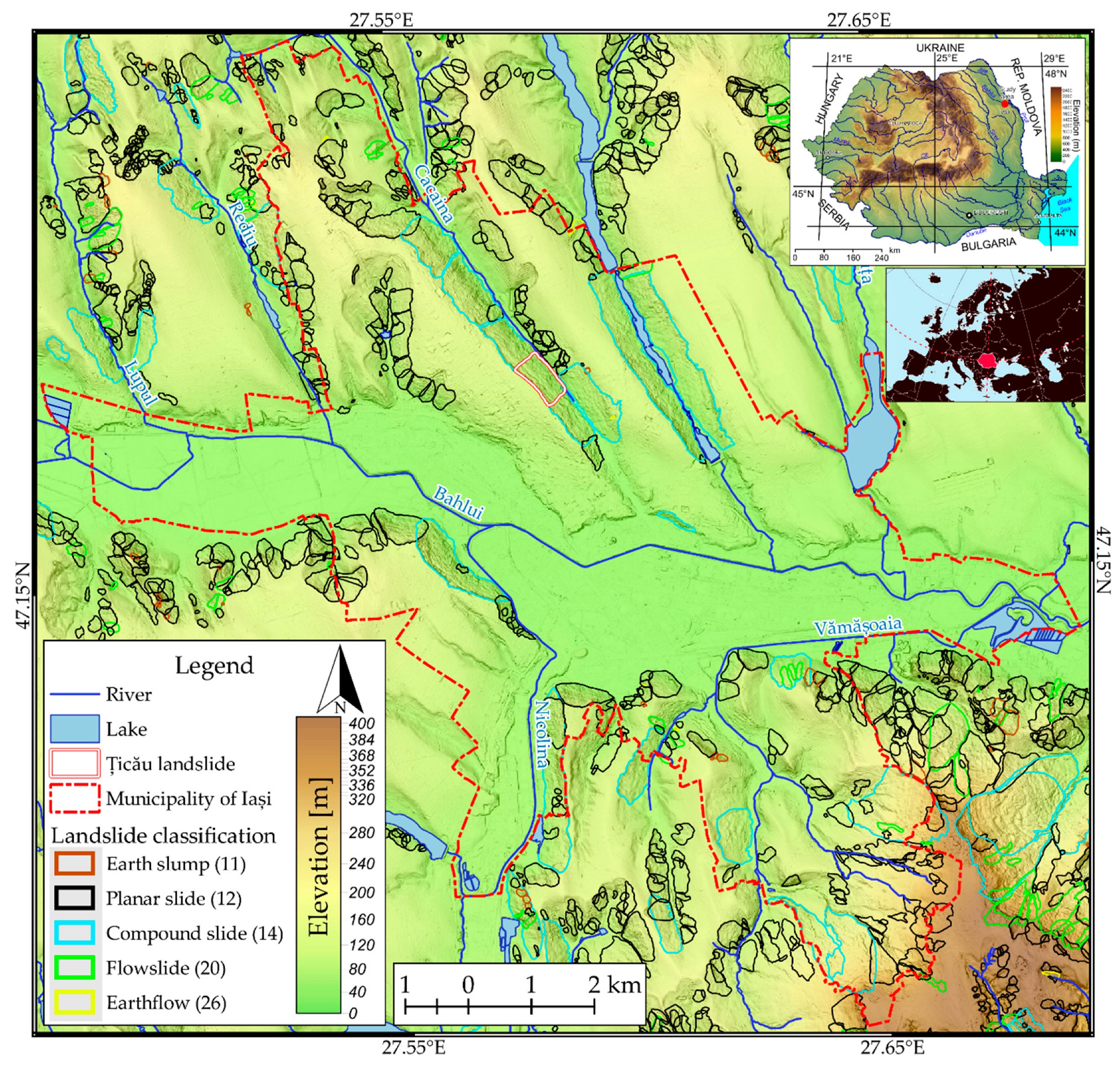
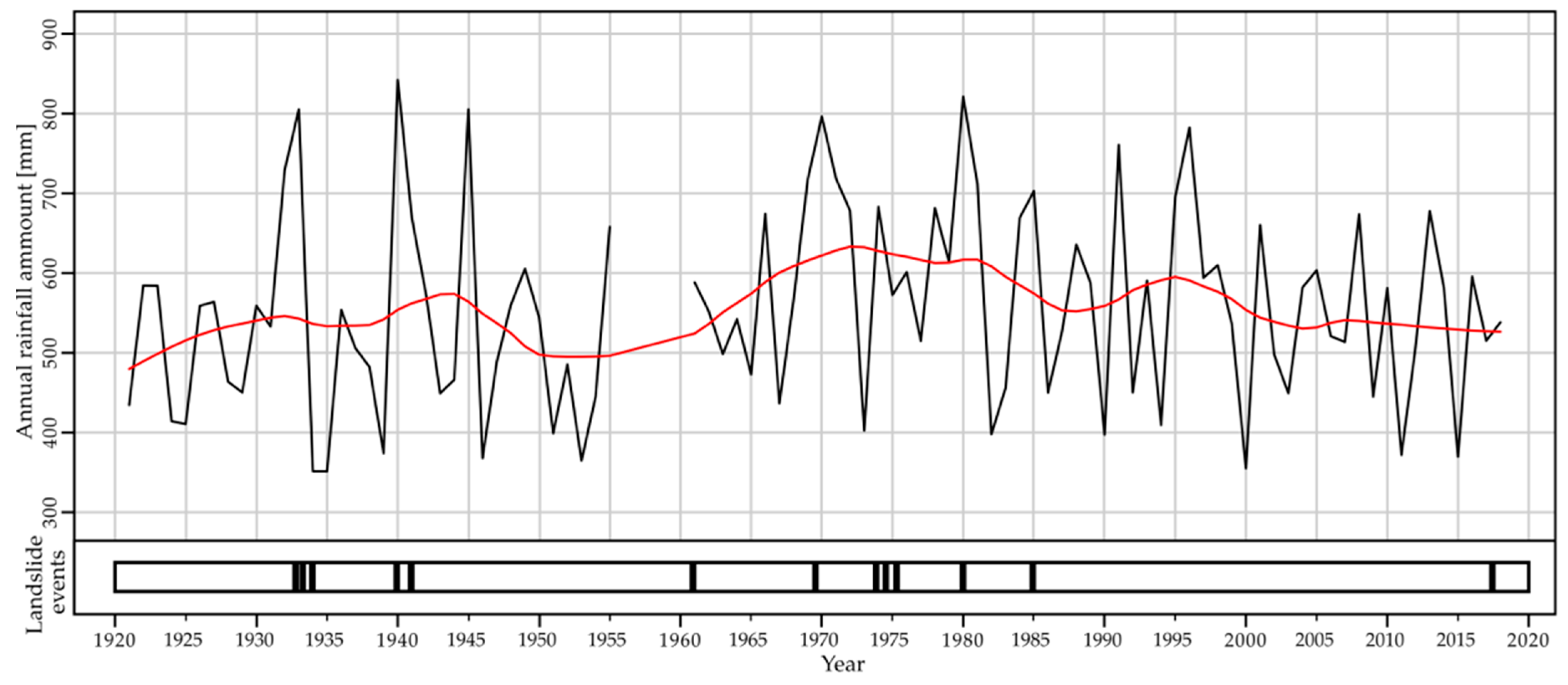
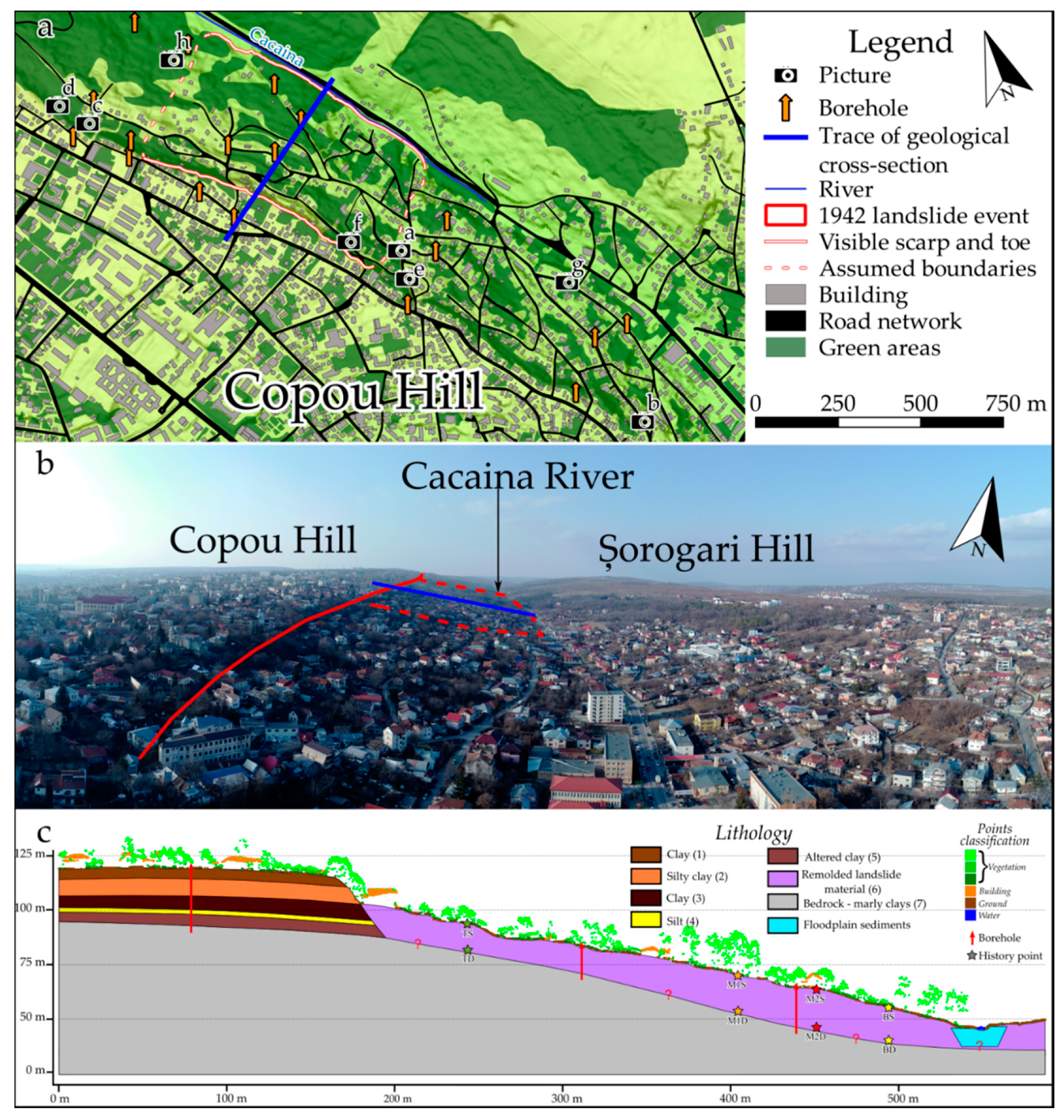
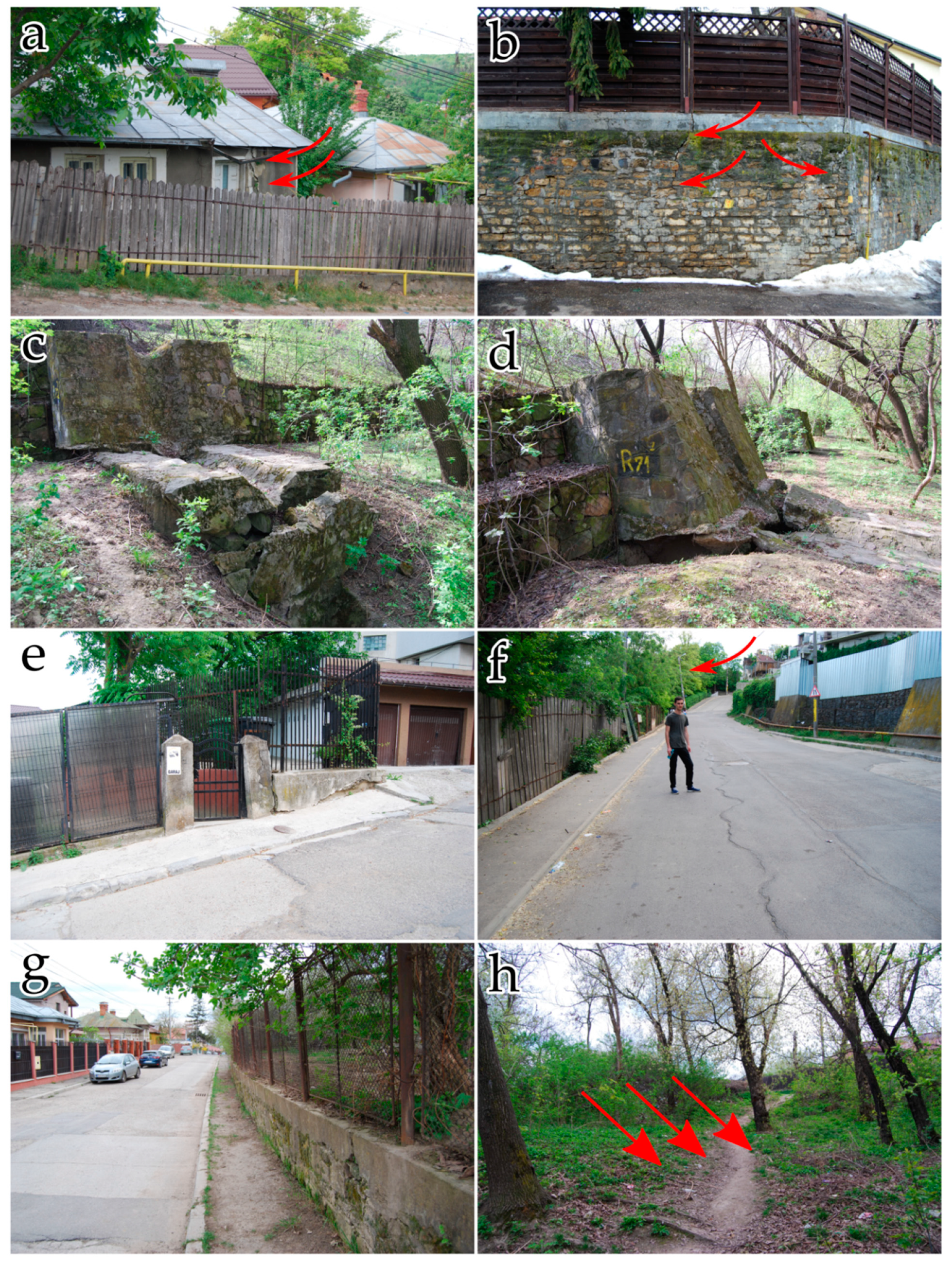
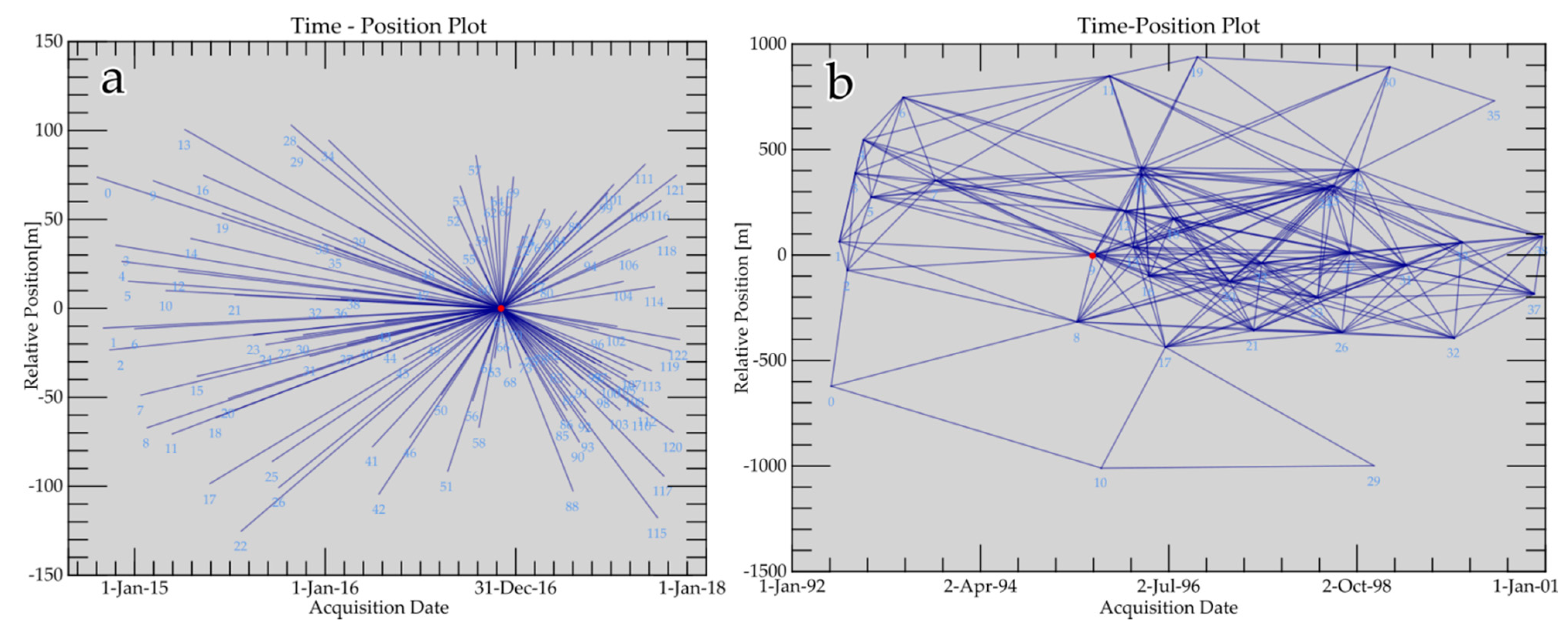
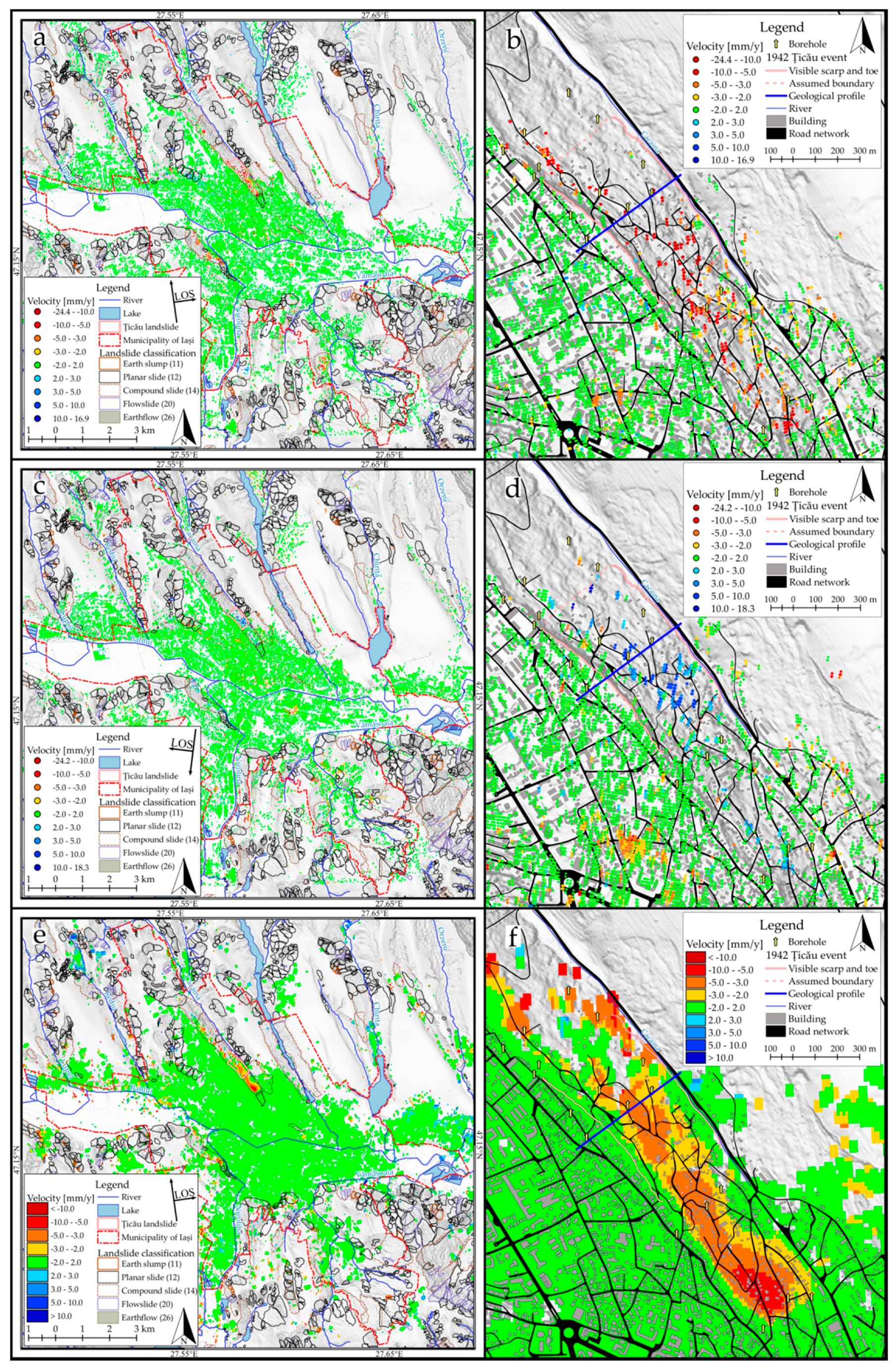
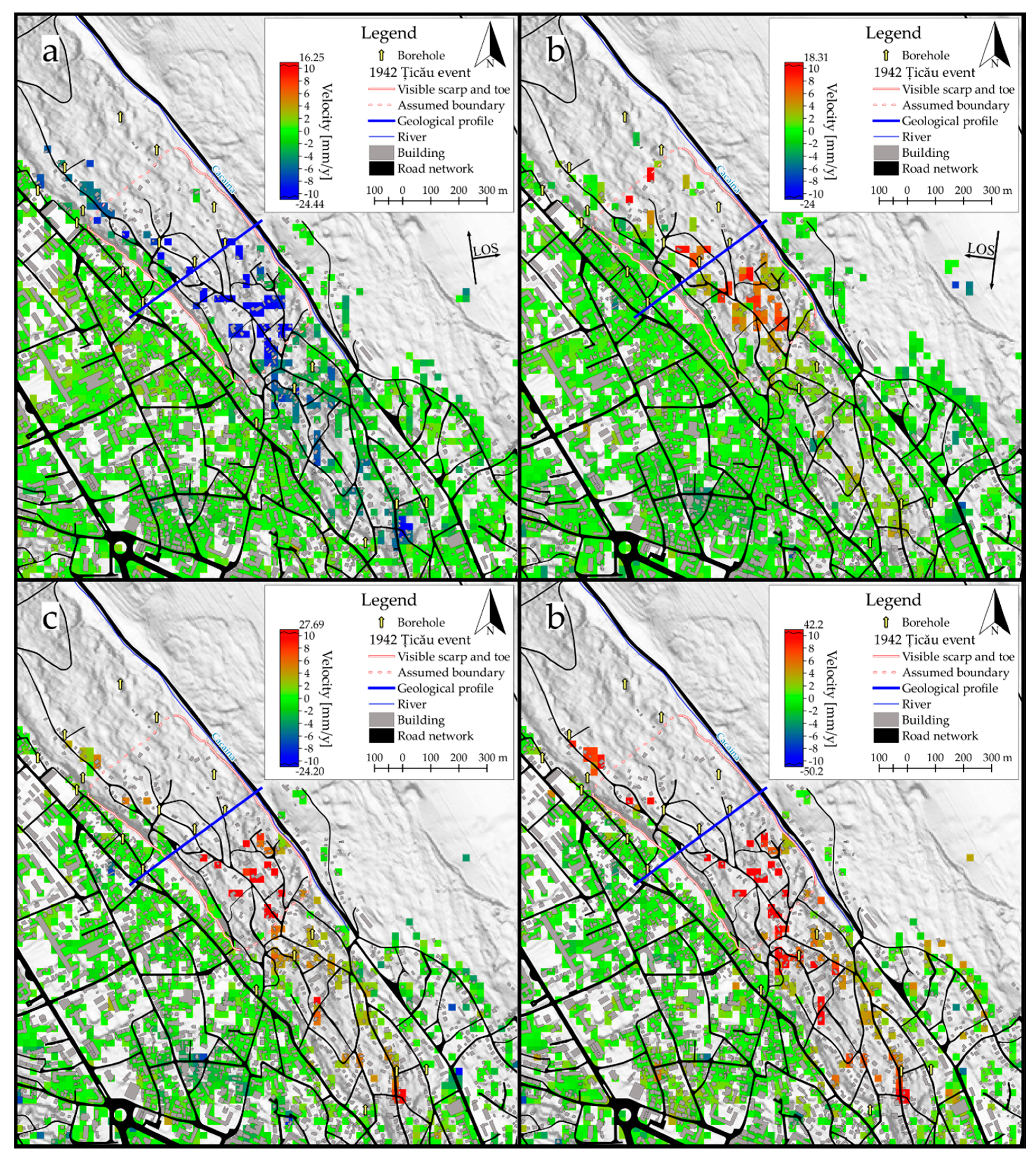

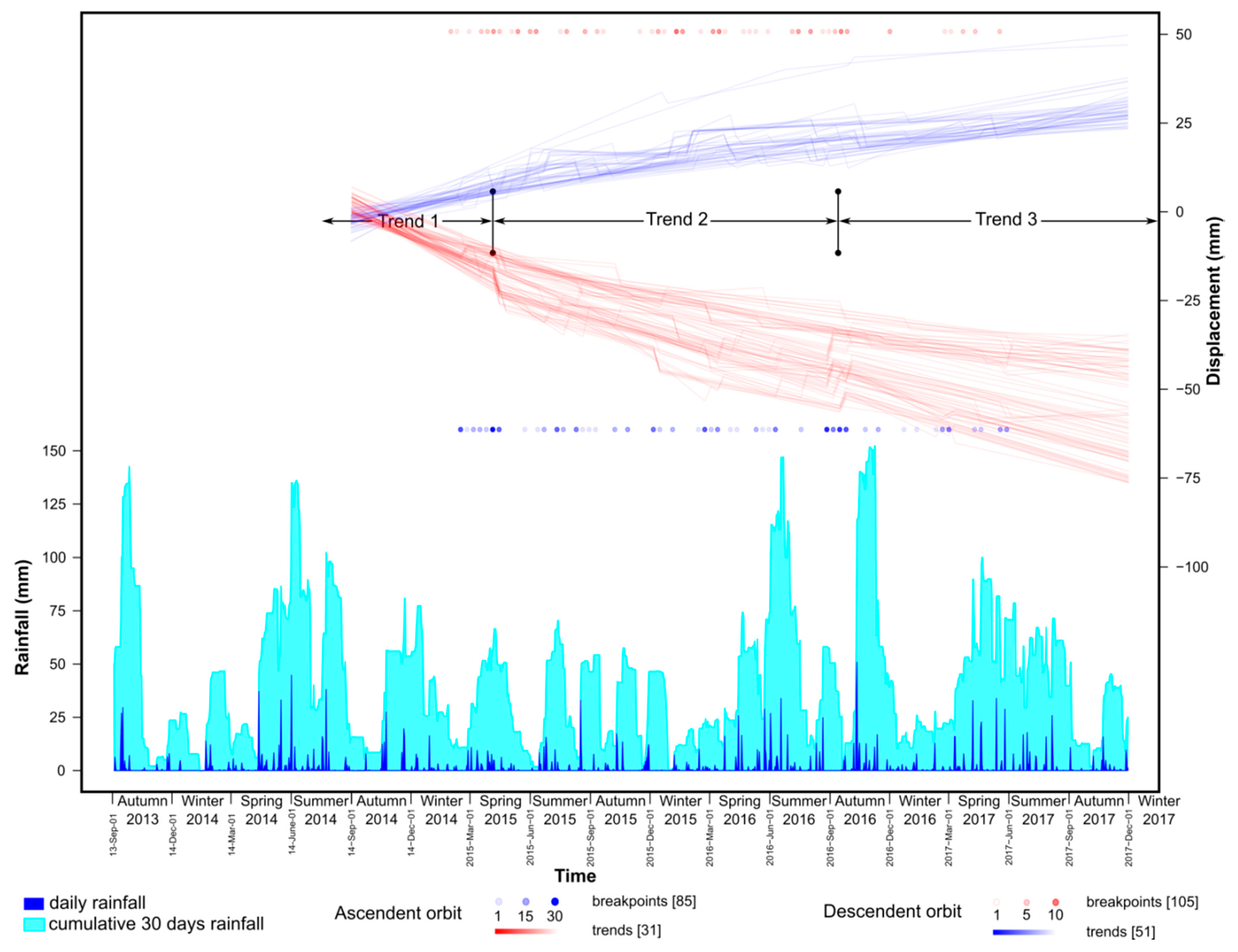

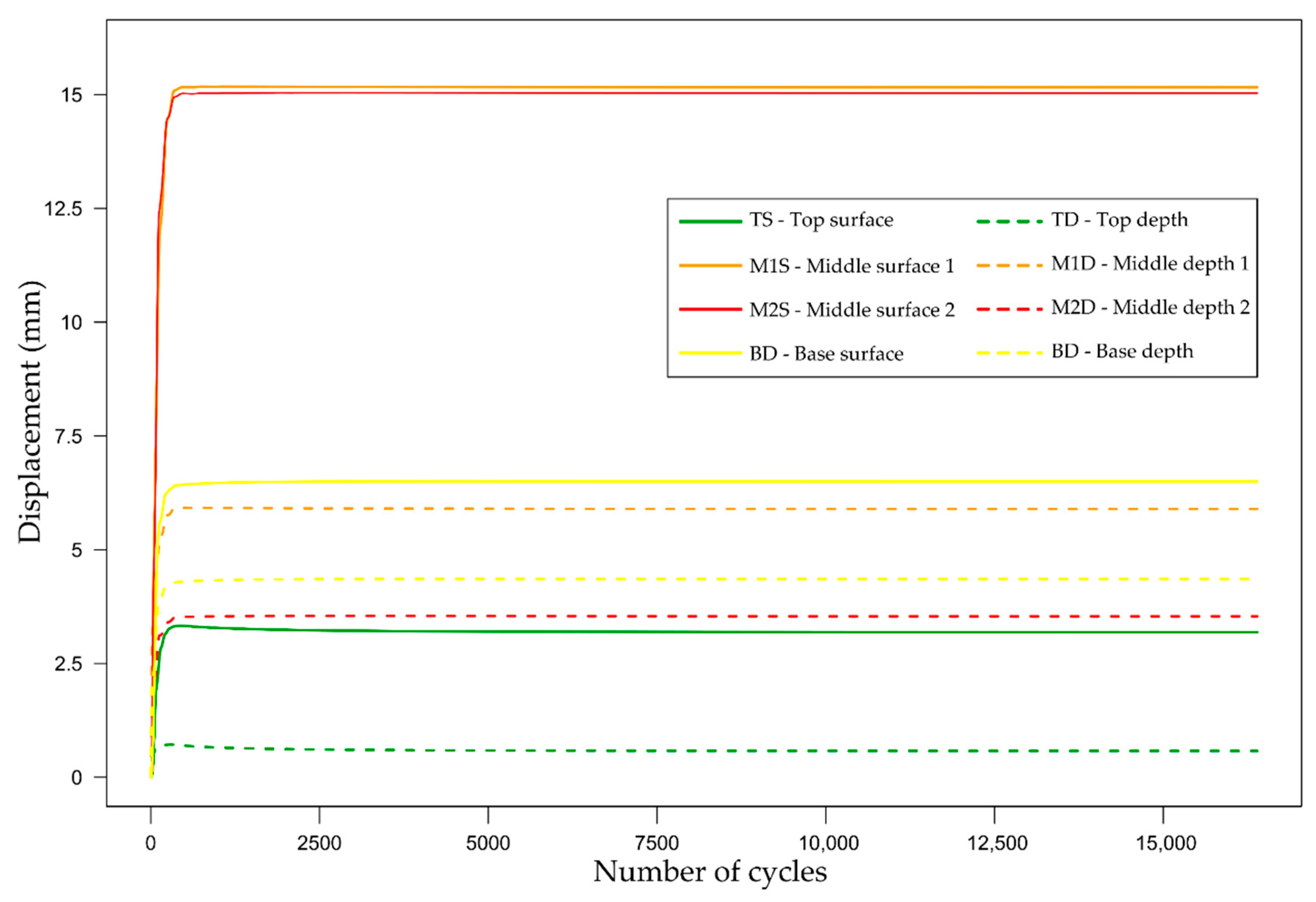

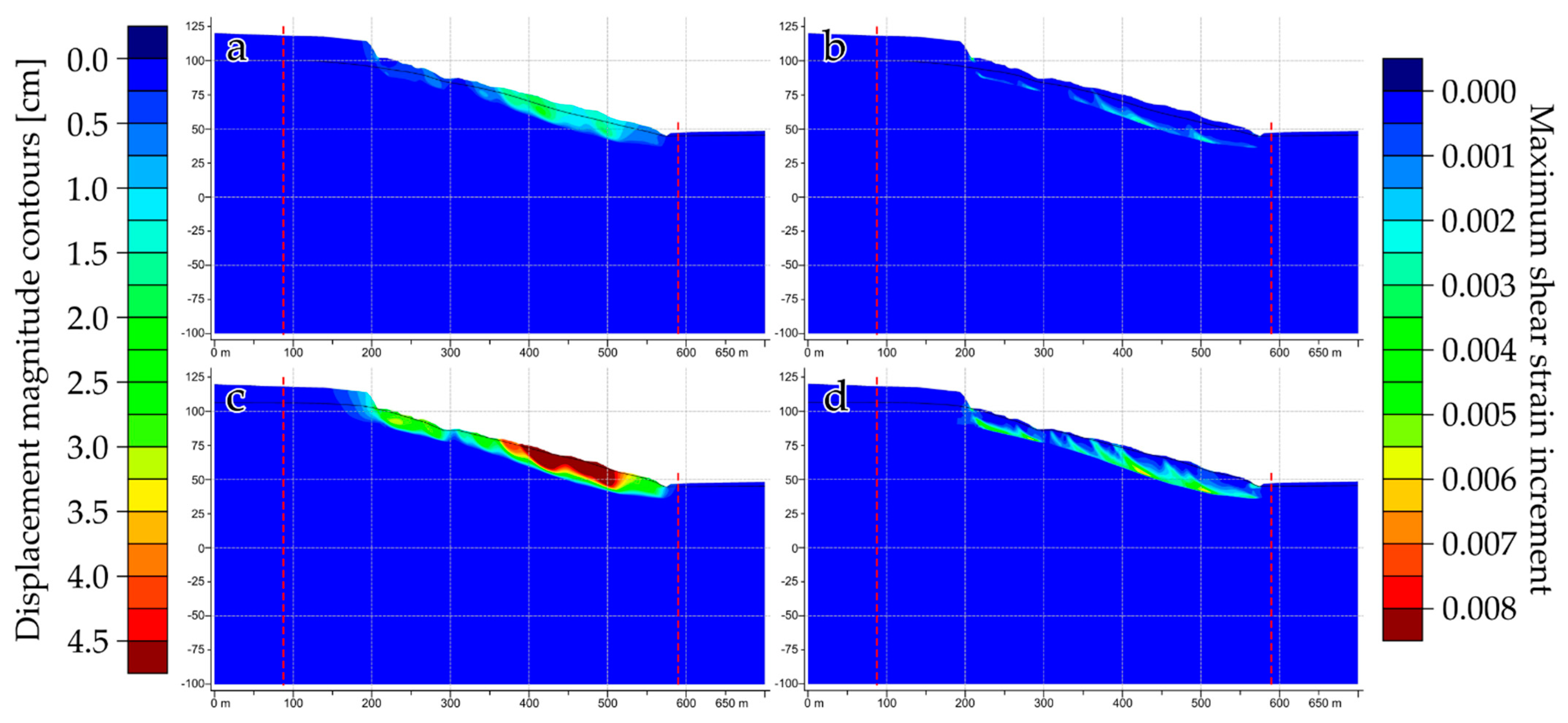
| Sensor | Parameters | ||||||||||
|---|---|---|---|---|---|---|---|---|---|---|---|
| Orbit Direction | Track No. | Time Interval | Repeat Cycle (days) | No. of Images | Product Type | Local Incidence Angle | Polarization | Azimuth res. (m) | Range res. (m) | Technique | |
| ERS-1 | Descending | 193 | 1992–1996 | 35 | 11 | SAR | ~22° | VV | 6 | 24 | SBAS |
| ERS-2 | 193 | 1995–2000 | 35 | 31 | SAR | ~22° | VV | 6 | 24 | ||
| ENVI SAT | Ascending | 429 | 2002–2009 | 35 | 19 | ASAR IM | ~23.5° | VV | 6 | 24 | |
| Descending | 193 | 2003–2010 | 35 | 20 | ASAR IM | ~22° | VV | 6 | 24 | ||
| Sentinel-1 A/B | Ascending | 58 | 2014–2017 | 12, 6 1 | 123 | Wide Swath | ~39° | VV | 5 | 20 | PS |
| Descending | 109 | 2014–2017 | 12, 6 1 | 127 | Wide Swath | ~37° | VV | 5 | 20 | ||
| Layer | Unit Weight [kN/m3] | ) | Effective Cohesion c’ [kPa] | Oedometric Module [kPa] | Tension t [kPa] | Young’s Modulus (E) [kPa] | Poisson’s Ratio (ν) |
|---|---|---|---|---|---|---|---|
| 1. Clay | 17.4 | 24º | 25 | 9243 | 20 | 7886.53 | 0.3 |
| 2. Silty clay | 19.2 | 25º | 20 | 6590 | 10 | 5622.87 | 0.3 |
| 3. Clay | 18.7 | 24º | 25 | 16,434 | 15 | 14,504.85 | 0.4 |
| 4. Silt | 20 | 27º | 10 | 12,520 | 5 | 10,682.60 | 0.3 |
| 5. Clay | 19.5 | 24º | 30 | 9522 | 20 | 8404.23 | 0.4 |
| 6. Landslide debris | 19.7 | 18º 20º 22º 25º | 2 5 10 15 | 9000 * | 0 1 2 3 | 15,000.0 | 0.4 |
| 7. Bedrock | 20.5 | 38º | 100 | 14,000 | 100 | 60,000.0 | 0.28 |
Publisher’s Note: MDPI stays neutral with regard to jurisdictional claims in published maps and institutional affiliations. |
© 2021 by the authors. Licensee MDPI, Basel, Switzerland. This article is an open access article distributed under the terms and conditions of the Creative Commons Attribution (CC BY) license (https://creativecommons.org/licenses/by/4.0/).
Share and Cite
Necula, N.; Niculiță, M.; Fiaschi, S.; Genevois, R.; Riccardi, P.; Floris, M. Assessing Urban Landslide Dynamics through Multi-Temporal InSAR Techniques and Slope Numerical Modeling. Remote Sens. 2021, 13, 3862. https://doi.org/10.3390/rs13193862
Necula N, Niculiță M, Fiaschi S, Genevois R, Riccardi P, Floris M. Assessing Urban Landslide Dynamics through Multi-Temporal InSAR Techniques and Slope Numerical Modeling. Remote Sensing. 2021; 13(19):3862. https://doi.org/10.3390/rs13193862
Chicago/Turabian StyleNecula, Nicușor, Mihai Niculiță, Simone Fiaschi, Rinaldo Genevois, Paolo Riccardi, and Mario Floris. 2021. "Assessing Urban Landslide Dynamics through Multi-Temporal InSAR Techniques and Slope Numerical Modeling" Remote Sensing 13, no. 19: 3862. https://doi.org/10.3390/rs13193862
APA StyleNecula, N., Niculiță, M., Fiaschi, S., Genevois, R., Riccardi, P., & Floris, M. (2021). Assessing Urban Landslide Dynamics through Multi-Temporal InSAR Techniques and Slope Numerical Modeling. Remote Sensing, 13(19), 3862. https://doi.org/10.3390/rs13193862









